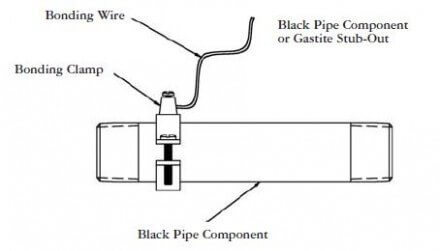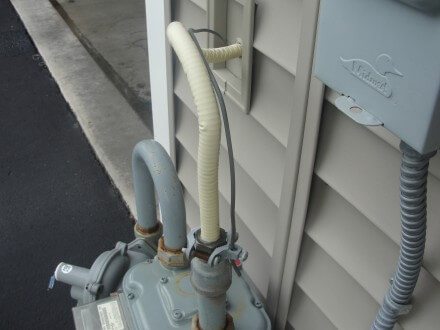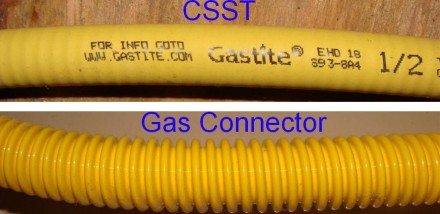I last blogged about CSST bonding nearly three years ago. There have been a few changes to CSST bonding rules since then, and there is still a lot of bad information circulating about CSST bonding and safety requirements, so it's time for an update on that topic.
First, a primer on CSST, which stands for Corrugated Stainless Steel Tubing. If you own a newer home or you've recently had gas lines added to your home, there’s a good possibility that CSST was used. This is a relatively new, flexible material that is approved for the distribution of natural gas inside of homes. The best analogy I can think of to describe this material is that CSST is to steel gas pipes what PEX is to copper tubing, or Romex® is to rigid metal conduit.
CSST needs to be bonded. The most common issue that home inspectors find with CSST is a system that hasn’t been properly bonded. When CSST is installed without being properly bonded to current standards, there is an increased risk for damage to the material from a nearby lightning strike. When CSST is damaged, it can leak gas and cause an explosion and/or a fire. To the best of my knowledge, all manufacturers of CSST began implementing specific bonding requirements around 2007.
What about existing installations? Building codes have something called ‘grandfathering’. This means that if something was installed to code, it’s still a code compliant installation today, even if the codes have changed significantly. The nice thing about being a home inspector is that we don’t need to get hung up on code requirements. If something is deemed unsafe due to a change in accepted residential construction standards, our Standards of Practice requires us to report on it.
If CSST was installed to code in 2005 and the manufacturer didn’t have any special requirements for bonding at the time it was installed, the installation still meets code today. That won't stop me from recommending the system be bonded to today’s standards thought. The manufacturers of CSST have changed their installation requirements because they’ve learned that the old methods weren’t good enough.
What does proper bonding look like? There needs to be a separate bonding wire connected either to the rigid gas piping before the CSST, or directly to one of the CSST nuts. This is needed any time CSST is installed, even if it's just a small amount. The diagram below shows an example of what this would look like when properly installed to today’s standards.
The photo below shows an example of CSST bonded at the exterior of the home, with the bonding clamp connected to the CSST nut.
The other end of that wire shown above went into the main electric panel. The video below, produced by Gastite, shows a couple examples of how to properly bond CSST.
While the old method for bonding CSST required a connection at the main electric panel, this is no longer required in Minnesota. Minnesota's 2015 Fuel Gas Code uses the 2012 International Fuel Gas Code, which requires CSST to be bonded anywhere along the electrical service grounding electrode system. That means that the bonding conductor for CSST can be connected to the metallic water piping coming into the home, a ground rod at the exterior, or anywhere else on the service grounding electrode system. This change makes it much easier to properly bond CSST.
Some manufacturers of CSST offer a product with a black outer "arc-resistant" jacket, which is designed to show that it's an arc-resistant product. Two such examples of these products are CounterStrike and FlashShield. While the manufacturers of these products do not require special bonding, the Minnesota Fuel Gas Code makes no exception to the bonding requirements for these products. They still need to be bonded. For more info on that topic, check out this document on CSST bonding from Pro-Flex.
How can you know if you have CSST in your home? Look for flexible tubing with a yellow or black jacket that covers the ridges. About 99% of the CSST I've seen has a yellow jacket. This material is not to be confused with an appliance connector, which might have a yellow coating that follows the contours of the ridges. The photo below shows the two different materials.
The bottom line is that if you have a home with CSST, you should make sure it’s properly bonded to today’s standards, regardless of whether the installation ‘met code’ when it was originally installed. Also, if your electrician tells you that bonding the CSST may increase the risk of a lightning strike, simply thank them for their time and call a different electrician.
Additional Information on CSST and bonding
- Basics of CSST – a brief description, a brief history, and some basic installation requirements
- CSST: Direct Bonding Required for All Brands
- Cutting Edge Solutions – this web site is filled with information related to CSST bonding requirements.
- Validation of Installation Methods for CSST Gas Piping to Mitigate Indirect Lightning Related Damage - the conclusion of this report says "With a sufficiently short bonding conductor, arcing is suppressed entirely, and the possibility of an arc discharge perforation is eliminated."
Also, here's an old news clip of me talking with Kare 11 news about CSST bonding:






